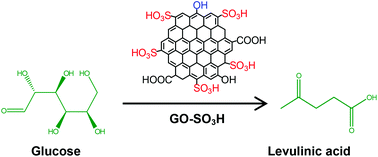DOI: 10.1039/C3GC40353J, Paper
Sulfonated graphene oxide (GO-SO3H) catalyst selectively decomposes glucose to levulinic acid (LA) with excellent yield (around 78%).
Chemical conversion of biomass-derived hexose sugars to levulinic acid over sulfonic acid-functionalized graphene oxide catalysts
Heterogeneous graphene oxide (GO)-based catalysts with sulfonic acid (SO3H) functional groups (GO–SO3H) were used for the selective decomposition of the hexose sugars, glucose and fructose into levulinic acid (LA), which has been used as a platform chemical for various value-added derivatives. The GO–SO3H catalysts gave high yields of around 78% for LA and showed good reuse compatibility with reliable performance. The chemical transformation patterns for hexose sugar decompositions are affected by the temperature, the density of acid sites, and the type of catalyst. The high catalytic performance of GO–SO3H was shown to result from the higher density of Brønsted acid sites in the GO, compared with the Lewis acid sites in other AC–SO3H catalysts. The morphology, surface characteristics, and other physiochemical properties were evaluated using several characterization techniques.
